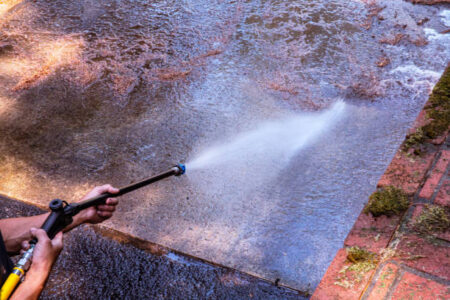Keeping your drains clean and free-flowing is essential for maintaining a healthy and functional plumbing system. Blocked drains can lead to a host of problems, from unpleasant odors to serious water damage. One of the most effective tools for clearing drains is the pressure washer drain jet. In this article, we’ll dive deep into what a pressure washer drain jet is, how it works, and why it’s a game-changer for both residential and commercial plumbing.
What is a Pressure Washer Drain Jet?
Definition and Functionality
A pressure washer drain jet is a specialized attachment for pressure washers designed to clear blockages and clean the insides of drains and pipes. It uses high-pressure water jets to break up and flush out debris, grease, and other obstructions.
Components of a Pressure Washer Drain Jet
A typical pressure washer drain jet setup includes:
- Nozzles: Various types, each designed for specific cleaning tasks.
- Hose: Flexible and durable to navigate through pipes.
- Pressure Washer Unit: Provides the necessary water pressure.
How Does a Pressure Washer Drain Jet Work?
Mechanism of Action
The high-pressure water jets from the nozzle are directed backward, propelling the hose forward through the drain while simultaneously breaking up and flushing out the blockage.
Types of Pressure Washer Drain Jets
There are several types of drain jet nozzles, including:
- Rotating Nozzles: For thorough cleaning.
- Penetrating Nozzles: For tough blockages.
- Flushing Nozzles: For rinsing and debris removal.
Benefits of Using a Pressure Washer Drain Jet
Efficiency and Speed
Pressure washer drain jets can quickly and effectively clear blockages that might take hours to tackle with traditional methods.
Cost-Effectiveness
By maintaining clear drains, you can avoid costly plumbing repairs and water damage.
Eco-Friendly
Pressure washer drain jets use water to clean, eliminating the need for harsh chemicals that can harm the environment.
Types of Pressure Washer Drain Jets
Residential vs. Commercial Use
Residential models are typically smaller and less powerful, designed for home use. Commercial models are more robust, suitable for larger-scale or industrial applications.
Different Nozzle Types
Choosing the right nozzle is crucial for the task at hand:
- Rotating Nozzles are great for comprehensive cleaning.
- Penetrating Nozzles are ideal for breaking up hard blockages.
- Flushing Nozzles are used for rinsing away debris.
Choosing the Right Pressure Washer Drain Jet
Factors to Consider
When selecting a pressure washer drain jet, consider:
- Pressure Output: Higher pressure for tougher blockages.
- Hose Length: Longer hoses for deeper drains.
- Nozzle Variety: Different nozzles for various tasks.
Top Brands and Models
Some reputable brands include:
- Kärcher
- Simpson
- Sun Joe
Step-by-Step Guide to Using a Pressure Washer Drain Jet
Preparation and Safety Measures
- Wear PPE: Gloves, goggles, and waterproof clothing.
- Check Equipment: Ensure all components are in good working condition.
- Clear the Area: Remove any items around the drain area.
Operation Instructions
- Attach the Nozzle: Secure the appropriate nozzle to the hose.
- Insert the Hose: Feed the hose into the drain.
- Activate the Pressure Washer: Start with lower pressure and gradually increase.
- Move the Hose: Slowly push the hose through the drain, allowing the jets to break up the blockage.
Post-Cleaning Tips
- Flush with Water: Run clean water through the drain to remove any remaining debris.
- Inspect the Drain: Use a drain camera if available to check for any remaining blockages.
Safety Precautions When Using a Pressure Washer Drain Jet
Personal Protective Equipment (PPE)
Always wear gloves, goggles, and waterproof clothing to protect yourself from high-pressure water and debris.
Avoiding Common Mistakes
- Don’t Use Excessive Pressure: Too much pressure can damage pipes.
- Regular Maintenance: Keep your equipment in good condition to prevent malfunctions.
Maintenance Tips for Your Pressure Washer Drain Jet
Routine Maintenance
- Clean Nozzles: After each use, clean the nozzles to prevent clogging.
- Inspect Hoses: Check for any signs of wear or damage.
- Store Properly: Keep the equipment in a dry place to avoid rust.
Troubleshooting Common Issues
- Low Pressure: Check for blockages in the hose or nozzle.
- Leaking Hose: Replace if there are any signs of cracks or holes.
Alternatives to Pressure Washer Drain Jets
Traditional Drain Snakes
Mechanical devices that manually break up blockages.
Chemical Drain Cleaners
Use with caution as they can damage pipes and harm the environment.
Yes, you can jet a drain with a pressure washer. Using a pressure washer to jet a drain is an effective and efficient method for clearing clogs and maintaining clean pipes. Here’s a step-by-step guide on how to do it:
1. Gather Your Equipment
- Pressure washer
- Drain jetting attachment (specialized nozzle)
- Safety gear (gloves, goggles)
- Access to a water source
2. Attach the Drain Jetting Nozzle
- Connect the drain jetting nozzle to the hose of your pressure washer. Ensure it is securely attached to prevent leaks and ensure optimal performance.
3. Insert the Nozzle into the Drain
- Carefully insert the nozzle into the drain. Make sure it is positioned correctly to effectively target the clog.
4. Start the Pressure Washer
- Turn on your pressure washer. Begin with a lower pressure setting to avoid damaging the pipes, then gradually increase the pressure if needed.
5. Move the Nozzle Back and Forth
- Slowly move the nozzle back and forth within the drain to dislodge and break up the clog. The high-pressure water will blast away debris, grease, and other obstructions.
FAQs About Pressure Washer Drain Jets
How often should I use a pressure washer drain jet?
It depends on usage, but typically every few months for preventive maintenance.
Can I use a regular pressure washer for drain jetting?
Yes, with the appropriate attachments.
What kind of debris can a pressure washer drain jet handle?
Grease, hair, soap scum, small tree roots, and other common blockages.
Are pressure washer drain jets safe for all types of pipes?
Generally, yes, but always check the manufacturer’s guidelines for compatibility with your pipe material.
How can I extend the lifespan of my pressure washer drain jet?
Regular maintenance, proper storage, and using the right nozzles for each job will help.
Conclusion!!
Using a pressure washer drain jet is an efficient, cost-effective, and eco-friendly way to maintain clear and functional drains. Whether for residential or commercial use, these tools can save time, money, and prevent the headaches associated with blocked drains.




